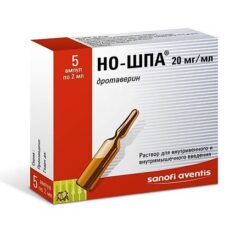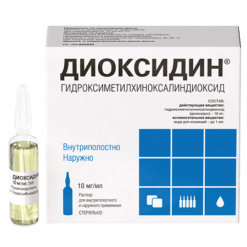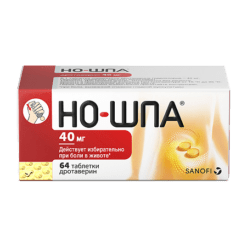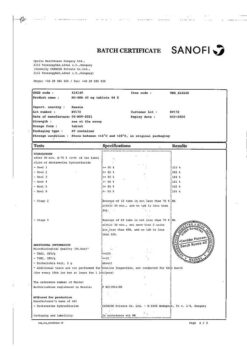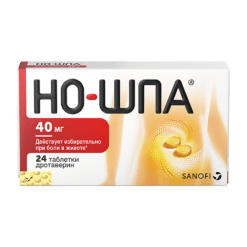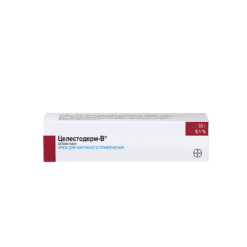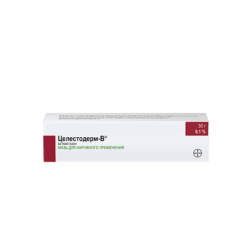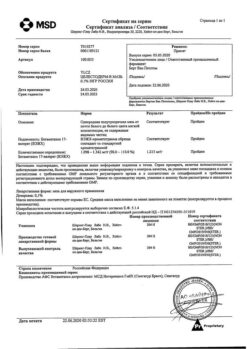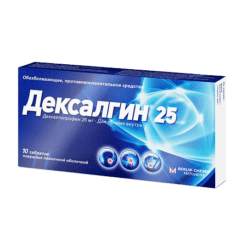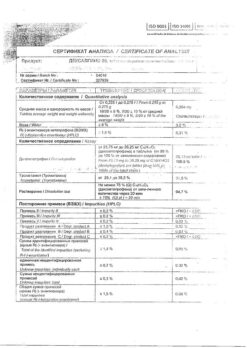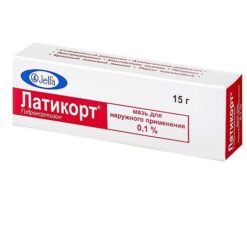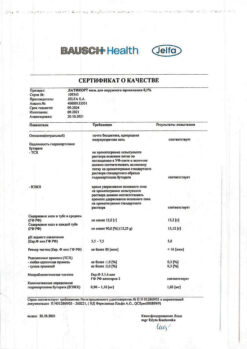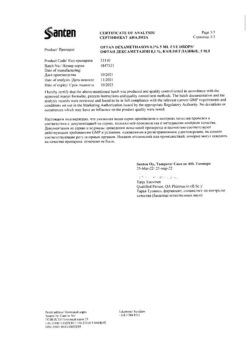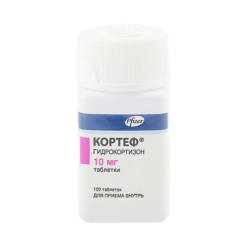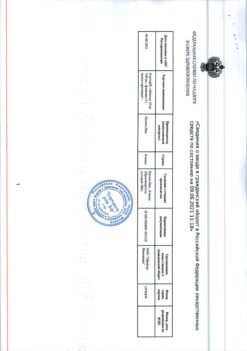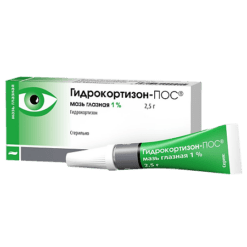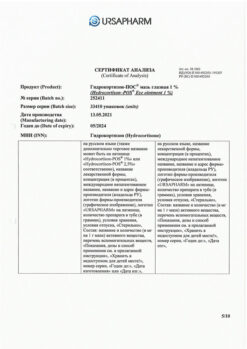No products in the cart.
No-shpa, 40 mg tablets 6 pcs
€1.00
Out of stock
(E-mail when Stock is available)
Description
Pharmgroup:
The antispasmodic agent.
Pharmic action:
No-spa is a myotropic antispasmodic, isoquinoline derivative. It has a powerful antispasmodic effect on smooth muscles by inhibiting the enzyme FDE. PDE enzyme is required for hydrolysis of cAMP to AMP. Inhibition of FDE leads to an increase in the concentration of cAMP, which triggers the following cascade reaction: high concentrations of cAMP activate cAMP-dependent phosphorylation of myosin light chain kinase (CLKM).
Phosphorylation of CLSM leads to a decrease in its affinity for the Ca2+-calmodulin complex; as a result, the inactivated form of CLSM maintains muscle relaxation. In addition, cAMP affects the cytosolic concentration of Ca2+ ion by stimulating Ca2+ transport into the extracellular space and the sarcoplasmic reticulum. This lowering of Ca2+-ion concentration by drotaverine through the cAMP explains the antagonistic effect of drotaverine with respect to Ca2+.
In vitro, drotaverine inhibits the FDE4 isoenzyme without inhibiting the FDE3 and FDE5 isoenzymes. Therefore, the effectiveness of drotaverine depends on the concentration of FDE4 in tissues (FDE4 content varies in different tissues). FDE4 is most important for inhibition of contractile activity of smooth muscles, therefore selective inhibition of FDE4 may be useful for treatment of hyperkinetic dyskinesias and various diseases accompanied by spastic state of GIT.
The hydrolysis of CAMP in the myocardium and vascular smooth muscle occurs primarily through the FDE3 isoenzyme, which explains the fact that with high antispasmodic activity, drotaverine has no serious cardiovascular side effects and pronounced effects on the cardiovascular system.
Drotaverine is effective for smooth muscle spasms of both neurogenic and muscular origin. Regardless of the type of autonomic innervation, drotaverine relaxes the smooth muscles of the gastrointestinal tract, biliary tract, genitourinary system.
Indications
Indications
spasms of the stomach and intestines
renal colic
painful menstruation
increased excitability of the uterus during pregnancy
biliary dyskinesia, biliary colic, cholecystitis.
Pharmacological effect
Pharmacological effect
Pharmgroup:
antispasmodic.
Pharmaceutical action:
No-spa is a myotropic antispasmodic, an isoquinoline derivative. It has a powerful antispasmodic effect on smooth muscles due to inhibition of the PDE enzyme. The enzyme PDE is necessary for the hydrolysis of cAMP to AMP. Inhibition of PDE leads to an increase in cAMP concentration, which triggers the following cascade reaction: high concentrations of cAMP activate cAMP-dependent phosphorylation of myosin light chain kinase (MLCK).
Phosphorylation of MLCK leads to a decrease in its affinity for the Ca2+-calmodulin complex, as a result of which the inactivated form of MLCK maintains muscle relaxation. In addition, cAMP affects the cytosolic concentration of Ca2+ ion by stimulating the transport of Ca2+ into the extracellular space and the sarcoplasmic reticulum. This lowering Ca2+ ion concentration effect of drotaverine through cAMP explains the antagonistic effect of drotaverine towards Ca2+.
In vitro, drotaverine inhibits the PDE4 isoenzyme without inhibiting the PDE3 and PDE5 isoenzymes. Therefore, the effectiveness of drotaverine depends on the concentration of PDE4 in tissues (the content of PDE4 in different tissues varies). PDE4 is most important for suppressing the contractile activity of smooth muscles, and therefore selective inhibition of PDE4 may be useful for the treatment of hyperkinetic dyskinesias and various diseases accompanied by a spastic state of the gastrointestinal tract.
The hydrolysis of cAMP in the myocardium and vascular smooth muscle occurs mainly with the help of the PDE3 isoenzyme, which explains the fact that with high antispasmodic activity, drotaverine has no serious side effects on the heart and blood vessels and no pronounced effects on the cardiovascular system.
Drotaverine is effective against smooth muscle spasms of both neurogenic and muscular origin. Regardless of the type of autonomic innervation, drotaverine relaxes the smooth muscles of the gastrointestinal tract, biliary tract, and genitourinary system.
Special instructions
Special instructions
The use of the drug for arterial hypotension requires increased caution.
Each tablet contains 104 mg of lactose.
When taken, up to 156 mg of lactose (1.5 tablets) can enter the body, which can cause gastrointestinal disorders in patients suffering from lactose intolerance.
The tablets are not suitable for patients suffering from lactose deficiency, galactosemia or impaired glucose/galactose absorption syndrome (see “Contraindications”).
Impact on the ability to drive a car or perform work that requires increased speed of physical and mental reactions.
When taken orally in therapeutic doses, drotaverine does not affect the ability to drive a car or perform work that requires increased attention.
If any side effects occur, the issue of driving and operating machinery requires individual consideration.
If dizziness occurs, you should avoid engaging in potentially hazardous activities, such as driving vehicles and operating machinery.
Active ingredient
Active ingredient
Drotaverine
Composition
Composition
Active ingredient:
drotaverine hydrochloride;
Excipients:
magnesium stearate;
talc;
povidone;
corn starch;
lactose monohydrate;
Pregnancy
Pregnancy
During pregnancy and lactation it can be used according to indications.
Contraindicated in children under 6 years of age.
Contraindications
Contraindications
hypersensitivity to drotaverine and/or excipients included in the drug;
severe liver or kidney failure;
severe heart failure (decreased cardiac output);
hereditary lactose intolerance, lactase deficiency, galactosemia or glucose/galactose malabsorption syndrome (due to the presence of lactose in the drug).
With caution: arterial hypotension.
Side Effects
Side Effects
From the cardiovascular system: rarely – rapid heartbeat, decreased blood pressure.
From the side of the central nervous system: rarely – headache, dizziness, insomnia.
From the gastrointestinal tract: rarely – nausea, constipation.
From the immune system: rarely – allergic reactions (angioedema, urticaria, rash, itching); unknown frequency – fatal and non-fatal anaphylactic shock has been reported with the use of the drug.
Interaction
Interaction
Levodopa. With simultaneous use, drotaverine can weaken the antiparkinsonian effect of levodopa, i.e. increase rigidity and tremors.
Papaverine, bendazole and other antispasmodics (including m-anticholinergics). Strengthening the antispasmodic effect.
Morphine. Reducing the spasmogenic activity of morphine.
Phenobarbital. Strengthening the antispasmodic effect of drotaverine.
Overdose
Overdose
Symptoms: Heart rhythm and conduction abnormalities, including complete bundle branch block and cardiac arrest, which can be fatal.
Treatment: In case of overdose, patients should be under medical supervision and, if necessary, treated symptomatically and aimed at maintaining basic body functions, including induction of vomiting or gastric lavage.
Storage conditions
Storage conditions
At temperatures below 30 °C
Shelf life
Shelf life
5 years
Manufacturer
Manufacturer
Hinoine Pharmaceutical and Chemical Plant, Hungary
Additional information
| Shelf life | 5 years |
|---|---|
| Conditions of storage | At temperatures below 30 °C |
| Manufacturer | Hinoin Pharmaceutical and Chemical Works, Hungary |
| Medication form | pills |
| Brand | Hinoin Pharmaceutical and Chemical Works |
Other forms…
Related products
Buy No-shpa, 40 mg tablets 6 pcs with delivery to USA, UK, Europe and over 120 other countries.


